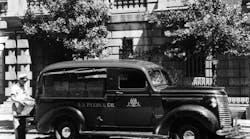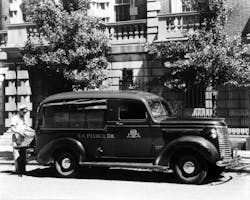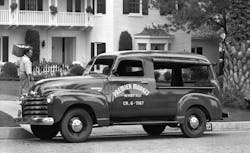In something of an interesting aside to the marketing promotions surrounding the new Chevrolet Express Van, General Motors provided a glimpse back into the history of such light commercial vehicles and especially the critical role they then played in urban communities.
“Before super markets became commonplace, vendors brought produce and baked goods to the buying public in city neighborhoods and the suburbs that were beginning to sprout up across the country at that time,” noted Greg Wallace, manager for General Motors Heritage Center in a statement.Thus small-sized commercial vans – ideally suited for negotiating cramped city streets – literally served as “mobile grocery stores” for urban denizens.
GM, of course, crafted several platforms specifically designed for such “mobile grocery store” operators.
Beginning in 1936, its Chevrolet division started selling the Chevrolet Canopy Pickup (above at left) – a vehicle based on Chevy’s FB-series half-ton pickup truck. Owners could add as options a canvas canopy top as well as side-drop curtains to the vehicle, making it an ideal mobile “food shop” for the times.Thirteen years later, GM unveiled the Chevrolet Canopy Express with in two versions: the 3100 Series half-ton (seen at right) and 3800 Series one-ton.
The OEM pointed out that heavier-duty 3800 sported a low rear tailgate and waterproof roll-up curtains, allowing food sellers back then easier access and better protection for their products.
A now, in a way, we’ve come full circle with the rise in popularity of food trucks bringing back some of that mobile-grocery mojo to our day and time.
Of course, the renaissance now occurring in the U.S. van market revolves around a lot more than giving food vendors a better, more efficient ride. It’s about re-inventing, in a way, a light commercial vehicle platform to better fit the needs of business today – better fuel economy and tighter turning radius yet married to in many cases more capability than ever before.
It sure makes for an interesting ride – both from a modern and historical perspective alike.





